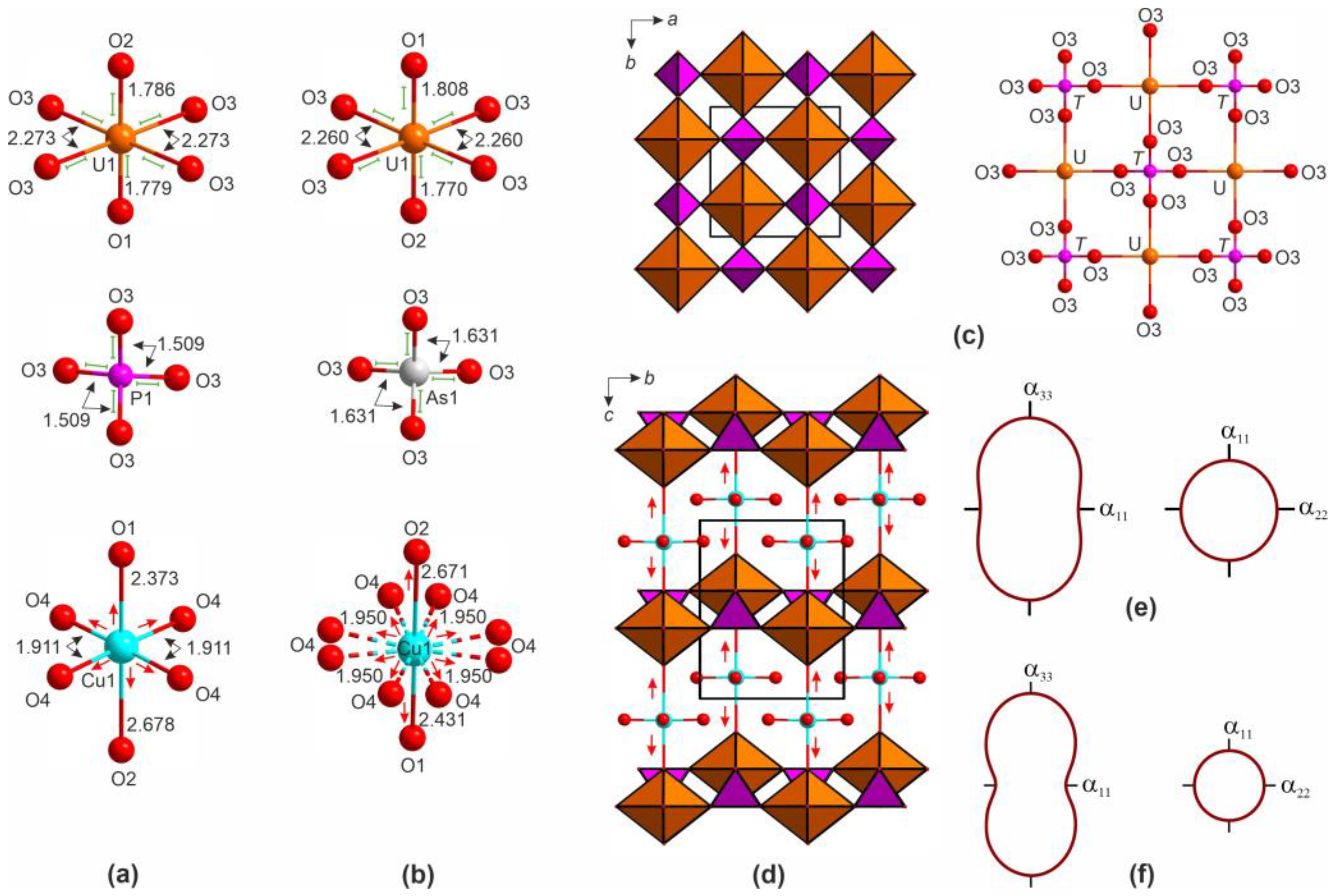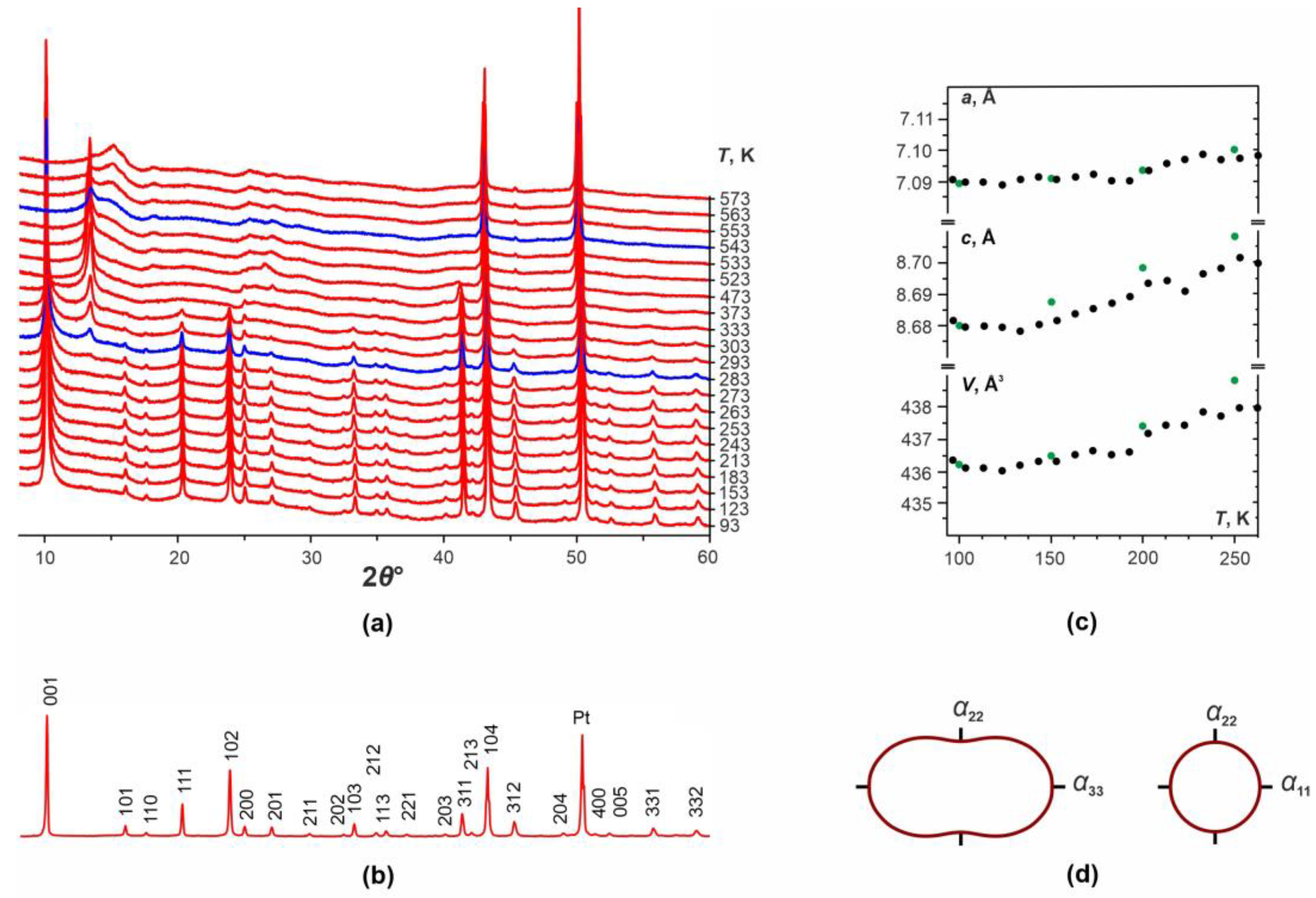High-Temperature Crystal Chemistry of Meta-Autunite Group Minerals: Metatorbernite, Cu(UO2)2(PO4)2(H2O)8 and Metazeunerite, Cu(UO2)2(AsO4)2(H2O)8
Abstract
:1. Introduction
2. Materials and Methods
2.1. Samples and Occurrence
2.2. Chemical Composition
2.3. Single-Crystal X-ray Diffraction Studies
2.4. Powder X-ray Diffraction Studies at Non-Ambient Temperatures
2.5. Thermodynamic Calculations
3. Results
3.1. Crystal Structure Description
3.2. Thermal Behavior of Metatorbernite and Metazeunerite Crystal Structures
3.3. Changes in the Standard Gibbs Energies of Formation Calculations
4. Discussion
5. Conclusions
Author Contributions
Funding
Data Availability Statement
Acknowledgments
Conflicts of Interest
References
- Krivovichev, S.V.; Plášil, J. Mineralogy and Crystallography of Uranium. In Uranium: From Cradle to Grave; MAC Short Courses; Burns, P.C., Sigmon, G.E., Eds.; Midlands Arts Centre: Birmingham, UK, 2013; Volume 43, pp. 15–119. [Google Scholar]
- Lussier, A.J.; Lopez, R.A.K.; Burns, P.C. A revised and expanded structure hierarchy of natural and synthetic hexavalent uranium compounds. Can. Mineral. 2016, 54, 177–283. [Google Scholar] [CrossRef]
- Cuney, M.; Kyser, K. Recent and Not-So-Recent Developments in Uranium Deposits and Implications for Exploration; Mineralogical Association of Canada: Quebec City, QC, Canada, 2008. [Google Scholar]
- Cretaz, F.; Szenknect, S.; Clavier, N.; Vitorge, P.; Mesbah, A.; Descostes, M.; Poinssot, C.; Dacheux, N. Solubility properties of synthetic and natural meta-torbernite. J. Nucl. Mater. 2013, 442, 195–207. [Google Scholar] [CrossRef]
- Hedman, T.; Nystrom, A.; Thegerstrom, C. Swedish containers for disposal of spent nuclear fuel and radioactive waste. Comptes Rendus Phys. 2002, 3, 903–913. [Google Scholar] [CrossRef]
- Rosborg, R.; Werme, L. The Swedish nuclear waste program and the long-term corrosion behaviour of copper. J. Nucl. Mater. 2008, 379, 142–153. [Google Scholar] [CrossRef]
- Finch, R.; Murakami, T. Systematics and paragenesis of uranium minerals. In Uranium: Mineralogy, Geology and the Environment; Burns, P.C., Finch, R., Eds.; Mineralogical Society of America: Washington, DC, USA, 1999; pp. 91–179. [Google Scholar]
- Beintema, J. On the composition and crystallography of autunite and the meta-autunites. Recl. Trav. Chim. Pays Bas. 1938, 57, 155–175. [Google Scholar] [CrossRef]
- Makarov, E.S.; Tobelko, K.I. Crystal structure of metatorbernite. Dokl. Akad. Nauk SSSR 1960, 131, 87–89. [Google Scholar]
- Ross, M.; Evans, H.T.; Appleman, D.E. Studies of the torbernite minerals. II. The crystal structure of meta-torbernite. Am. Mineral. 1964, 49, 1603–1621. [Google Scholar]
- Stergiou, A.C.; Rentzeperis, P.J.; Sklavounos, S. Refinement of the crystal structure of metatorbernite. Z. Kristallogr. 1993, 205, 1–7. [Google Scholar] [CrossRef]
- Calos, N.J.; Kennard, C.H.L. Crystal structure of copper bis(uranyl phosphate) octahydrate (metatorbernite), Cu(UO2PO4)2×8(H2O). Z. Kristallogr. 1996, 211, 701–702. [Google Scholar] [CrossRef]
- Locock, A.J.; Burns, P.C. Crystal structures and synthesis of the copper-dominant members of the autunite and meta-autunite groups: Torbernite, zeunerite, metatorbernite and metazeunerite. Can. Miner. 2003, 41, 489–502. [Google Scholar] [CrossRef]
- Kulaszewska, J.; Dann, S.; Warwick, P.; Kirk, C. Solid solution formation in the metatorbernite–metazeunerite system (Cu(UO2)2(PO4)2−x(AsO4)x.nH2O) and their stability under conditions of variable temperature. Phil. Trans. R. Soc. 2018, 377, 20180242. [Google Scholar] [CrossRef] [PubMed]
- Hanic, F. The crystal structure of meta-zeunerite Cu(UO2)2(AsO4)2×8(H2O). Czech. J. Phys. 1960, B10, 169–181. [Google Scholar] [CrossRef]
- Hennig, C.; Reck, G.; Reich, T.; Rossberg, A.; Kraus, W.; Sieler, J. EXAFS and XRD investigations of zeunerite and meta-zeunerite. Z. Kristallogr. 2003, 218, 37–45. [Google Scholar] [CrossRef]
- Frost, R.L.; Weier, M.L.; Adebajo, M.O. Thermal decomposition of metazeunerite—A high-resolution thermogravimetric and hot-stage Raman spectroscopic study. Thermochim. Acta 2004, 419, 119–129. [Google Scholar] [CrossRef]
- Suzuki, Y.; Sato, T.; Isobe, H.; Kogure, T.; Murakami, T. Dehydration processes in the meta-autunite group minerals meta-autunite, metasaléeite, and metatorbernite. Amer. Mineral. 2005, 90, 1308–1314. [Google Scholar] [CrossRef]
- Locock, A.J. Crystal chemistry of actinide phosphates and arsenates. In Structural Chemistry of Inorganic Actinide Compounds; Krivovichev, S.V., Burns, P.C., Tananaev, I.G., Eds.; Elsevier: Amsterdam, The Netherlands, 2007; pp. 217–278. [Google Scholar]
- Frost, R.L.; Kristóf, J.; Weier, M.L.; Martens, W.N.; Horváth, E. Thermal decomposition of metatorbernite—A controlled rate thermal analysis study. J. Therm. Anal. Calorim. 2005, 79, 721–725. [Google Scholar] [CrossRef]
- Pozas-Tormo, R.; Moreno-Real, L.; Martinez-Lara, M.; Bruque-Gamez, S. Layered metal uranyl phosphates. Retention of divalent ions by amine intercalates of uranyl phosphates. Can. J. Chem. 1986, 64, 30. [Google Scholar] [CrossRef]
- Ambartsumyan, T.L.; Basalova, G.I.; Gorzhevskaya, S.A. Thermal Investigations of Uranium and Uranium-Bearing Minerals; Gosatomizdat: Moscow, Russia, 1961; 148p. (In Russian) [Google Scholar]
- Cejka, J.; Muck, A. Thermal analysis and infrared spectra of some natural and synthetic uranium micas. Thermochim. Acta 1985, 86, 387. [Google Scholar] [CrossRef]
- Vochten, R.; Huybrechts, W.; Remaut, G.; Deliens, M. Formation of meta-torbernite starting from curite: Crystallographic data and electrokinetic properties. Phys. Chem. Miner. 1979, 4, 281–290. [Google Scholar] [CrossRef]
- Vochten, R.; Piret, P.; Goeminne, A. Synthesis, crystallographic data, solubility and electrokinetic properties of copper-, nickel- and cobalt-uranylphosphate. Bull. Minéral. 1981, 104, 457–467. [Google Scholar] [CrossRef]
- Chernorukov, N.G.; Nipruk, O.V.; Knyazev, A.V.; Pykhova, Y.P. Synthesis and study of uranyl arsenate (UO2)3(AsO4)2×12H2O. Z. Neorg. Khim. 2011, 56, 199–203. [Google Scholar] [CrossRef]
- Filenko, R.A.; Yurgenson, G.A.; Smirnova, O.K. New data on mineralogy of the oxidation zone of the Sherlovogorsky ore area (Eastern Transbaikalia). Geosph. Res. 2018, 4, 44–55. [Google Scholar] [CrossRef]
- Fraser, W. Diffractometers for modern X-ray crystallography: The XtaLAB Synergy X-ray diffractometer platform. Rigaku J. 2020, 36, 37–47. [Google Scholar]
- CrysAlisPro Software System, version 1.171.41.94a; Rigaku Oxford Diffraction: Oxford, UK, 2021.
- Sheldrick, G.M. Crystal structure refinement with SHELXL. Acta Crystallogr. 2015, C71, 3–8. [Google Scholar]
- Downs, R.T. Analysis of harmonic displacement factors. Rev. Mineral. Geochem. 2000, 41, 61–87. [Google Scholar]
- Spek, A.L. An overview of PLATON/PLUTON crystal structure validation. Acta Cryst. 2020, E76, 1–11. [Google Scholar] [CrossRef]
- Bruker TOPAS, version 5.0; Bruker AXS Inc.: Madison, WI, USA, 2014.
- Bubnova, R.S.; Firsova, V.A.; Filatov, S.K. Software for determining the thermal expansion tensor and the graphic representation of its characteristic surface (theta to tensor-TTT). Glass Phys. Chem. 2013, 39, 347–350. [Google Scholar] [CrossRef]
- Chudnenko, K.V. Thermodynamic Modeling in Geochemistry: Theory, Algorithms, Software, Applications; Academic Publishing House Geo: Novosibirsk, Russia, 2010; 287p. (In Russian) [Google Scholar]
- Grenthe, I.; Gaona, X.; Plyasunov, A.V.; Rao, L.; Runde, W.H.; Grambow, B.; Konings, R.J.M.; Smith, A.L.; Moore, E.E. Second Update on the Chemical Thermodynamics of Uranium, Neptunium, Plutonium, Americium and Technetium, Chemical Thermodynamics; Nuclear Energy Agency, OECD: Paris, France, 2021; Volume 14. [Google Scholar]
- Yokokawa, H. Tables of thermodynamic properties of inorganic compounds. J. Nation. Chem. Lab. Ind. 1988, 83, 27–118. [Google Scholar]
- Reid, R.; Prausnitz, J.; Sherwood, T. The Properties of Gases and Liquids, 3rd ed.; McGrawHill Book Company: New York, NY, USA, 1977; 592p. [Google Scholar]
- Burns, P.C.; Hawthorne, F.C. Coordination-geometry structural pathways in Cu2+ oxysalt minerals. Can. Mineral. 1995, 33, 889–905. [Google Scholar]
- Gagne, O.C.; Hawthorne, F.C. Bond-length distributions for ions bonded to oxygen: Alkali and alkaline-earth metals. Acta Crystallogr. Sect. B Struct. Sci. 2016, 72, 602–625. [Google Scholar] [CrossRef]
- Stubbs, J.E.; Post, J.E.; Elbert, D.C.; Heaney, P.J.; Veblen, D.R. Uranyl phosphate sheet reconstruction during dehydration of metatorbernite [Cu(UO2)2(PO4)2·8H2O]. Amer. Mineral. 2010, 95, 1132–1140. [Google Scholar] [CrossRef]
- Eremin, O.V. Method for calculating changes in the standard Gibbs energies of formation of minerals that belong to the class of uranophosphates. Radiochemistry 2020, 62, 480–491. [Google Scholar] [CrossRef]
- Eremin, O.V.; Rusal’, O.S.; Solodukhina, M.A.; Epova, E.S. Procedure for calculating the standard Gibbs potentials of minerals of the class of uranoarsenates. Russ. J. Phys. Chem. A 2020, 94, 678–686. [Google Scholar] [CrossRef]
- Nipruk, O.V.; Chernorukov, N.G.; Godovanova, N.S.; Arova, M.I. State of uranophosphates MII(PUO6)2·nH2O (MII = Mn2+, Co2+, Ni2+, Cu2+, Zn2+, Cd2+, Pb2+) in aqueous solutions. Radiochemistry 2012, 54, 528–536. [Google Scholar] [CrossRef]
- Chernorukov, N.G.; Nipruk, O.V.; Pykhova, Y.P.; Godovanova, N.S. Study of the state of uranoarsenates MII(PUO6)2·nH2O (MII = Mn2+, Co2+, Ni2+, Cu2+, Zn2+, Cd2+, Pb2+) in aqueous solutions. Russ. J. Gen. Chem. 2012, 82, 1348–1356. [Google Scholar] [CrossRef]
- Moroz, I.K.; Valueva, A.A.; Sidorenko, G.A.; Zhil’tsova, I.G.; Karpova, L.N. The crystal chemistry of uranium micas. Geokhimiya 1973, 18, 210–223. (In Russian) [Google Scholar]





| 1 | 2a | |
|---|---|---|
| Temperature (K) | 100 | |
| Radiation, λ (Å) | MoKα, 0.71073 | |
| Crystal system | tetragonal | |
| Space group | P4/nmm | |
| a (Å) | 6.9589(2) | 7.0896(2) |
| c (Å) | 8.6170(4) | 8.6802(5) |
| Volume (Å3) | 417.29(3) | 436.29(4) |
| Crystal size (mm3) | 0.15 × 0.06 × 0.04 | 0.17 × 0.07 × 0.05 |
| θ range (°) | 3.76–27.50 | 3.71–28.39 |
| h, k, l ranges | −8 → 7, | −7 → 9, |
| −9 → 9, | −8 → 9, | |
| −8 → 11 | −11 → 7 | |
| Total reflections collected | 2058 | 1869 |
| Unique reflections (Rint) | 0.038 | 0.045 |
| R1[F > 4σF], wR1[F > 4σF] | 0.021, 0.055 | 0.051, 0.13 |
| Rall, wRall | 0.023, 0.056 | 0.058, 0.14 |
| Highest difference peak | 1.96 | 4.54 |
| Deepest hole | −1.20 | −2.46 |
| Goodness-of-fit | 1.089 | 1.118 |
| ICSD | 2307946 | 2307947 |
| Compound | g(CuO), kJ/mol | g(H2O), kJ/mol | g(UO3), kJ/mol | g(T2O5), T = P, As, kJ/mol |
|---|---|---|---|---|
| 1 | −238.573 | −239.035 | −1240.771 | −1499.603 |
| 2 | −178.408 | −259.211 | −1142.566 | −818.766 |
Disclaimer/Publisher’s Note: The statements, opinions and data contained in all publications are solely those of the individual author(s) and contributor(s) and not of MDPI and/or the editor(s). MDPI and/or the editor(s) disclaim responsibility for any injury to people or property resulting from any ideas, methods, instructions or products referred to in the content. |
© 2023 by the authors. Licensee MDPI, Basel, Switzerland. This article is an open access article distributed under the terms and conditions of the Creative Commons Attribution (CC BY) license (https://creativecommons.org/licenses/by/4.0/).
Share and Cite
Nazarchuk, E.V.; Gurzhiy, V.V.; Tagirova, Y.G.; Charkin, D.O.; Krzhizhanovskaya, M.G.; Kasatkin, A.V.; Eremin, O.V. High-Temperature Crystal Chemistry of Meta-Autunite Group Minerals: Metatorbernite, Cu(UO2)2(PO4)2(H2O)8 and Metazeunerite, Cu(UO2)2(AsO4)2(H2O)8. Crystals 2023, 13, 1688. https://doi.org/10.3390/cryst13121688
Nazarchuk EV, Gurzhiy VV, Tagirova YG, Charkin DO, Krzhizhanovskaya MG, Kasatkin AV, Eremin OV. High-Temperature Crystal Chemistry of Meta-Autunite Group Minerals: Metatorbernite, Cu(UO2)2(PO4)2(H2O)8 and Metazeunerite, Cu(UO2)2(AsO4)2(H2O)8. Crystals. 2023; 13(12):1688. https://doi.org/10.3390/cryst13121688
Chicago/Turabian StyleNazarchuk, Evgeny V., Vladislav V. Gurzhiy, Yana G. Tagirova, Dmitri O. Charkin, Maria G. Krzhizhanovskaya, Anatoly V. Kasatkin, and Oleg V. Eremin. 2023. "High-Temperature Crystal Chemistry of Meta-Autunite Group Minerals: Metatorbernite, Cu(UO2)2(PO4)2(H2O)8 and Metazeunerite, Cu(UO2)2(AsO4)2(H2O)8" Crystals 13, no. 12: 1688. https://doi.org/10.3390/cryst13121688






